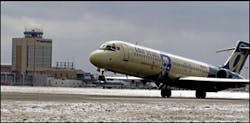GREEN, Ohio (AP) -- Akron-Canton Airport and some other small to midsize airports are taking business from larger hubs with a formula for success that starts with a discount airline. Add in proximity to a big metro area, light traffic and short lines and the passengers seem to follow.
''I love this airport,'' said Elaine Smolka of suburban Chicago after taking a United Express flight to Akron-Canton this week.
Smolka was drawn to Akron-Canton by its low fares, but uses it exclusively when visiting relatives in the area because of its short lines and breathing room. Smolka said even if she has to pay a little more, she prefers it over the nearby, but busier, Cleveland Hopkins International Airport.
Smolka's not alone in her admiration for Akron-Canton, which has tripled its number of passengers in the last 10 years to nearly 1.4 million last year. Except for 2001, Akron-Canton's passenger traffic has increased every year since AirTran Airways began flying from there in 1996.
''We couldn't do it without them,'' airport director Fred Krum said.
Cleveland Hopkins served 11.3 million passengers last year, down from 13.3 million in 2000. In 1996, it served 11.6 million passengers.
Officials at Cleveland Hopkins and Akron-Canton said they're not in competition with each other and that both are benefiting from airline rivalries that drive down ticket prices and attract more fliers.
Low-fare airlines such as AirTran, JetBlue Airways Corp. and Southwest Airlines Co. have been the key to success for smaller airports, said Richard V. Butler, professor of economics at Trinity University in San Antonio. Passengers are attracted to the low fares and rival carriers are drawn in to compete for the new traffic that's been generated.
Akron-Canton has a lot in common with Bishop International Airport in Flint, Mich., which topped 1 million passengers last year.
AirTran spokeswoman Judy Graham-Weaver said the company chose Akron-Canton and Flint because the airports were near big cities where major carriers faced little competition.
''Akron-Canton and Flint are both airports that have been very successful for us,'' she said.
Both airports are blessed with great locations. Akron-Canton is just 50 miles from Cleveland. Bishop is 70 miles from Detroit and the closest airport to booming Oakland County.
''These are airports that have repositioned themselves as secondary access points to a big area,'' said Mike Boyd, president of The Boyd Group, an Evergreen, Colo.-based aviation consulting firm.
Smaller airports are compatible with discount airlines because of low landing fees and their ability to get passengers in and out faster, limiting downtime on the runway, which is crucial to the airlines' low-cost model, said Hugo Burge, president of Cheapflights.com.
Manchester Airport in New Hampshire follows the formula, drawing from Logan International Airport in Boston 50 miles away.
Congestion at and around Logan and Manchester's addition of Southwest Airlines have helped it grow from 1 million passengers in 1997 to 4 million last year.
''We truly have become Boston's other airport,'' said assistant airport director J. Brian O'Neill.
JetBlue is responding with a massive expansion at Logan that includes plans for 100 daily flights out of Boston by 2008, up from 19 daily flights today.
Although there's more competition, O'Neill said it isn't exactly Manchester vs. Logan.
''Airports don't compete against other airports,'' O'Neill said. ''It's really airlines competing against other airlines. It will be interesting seeing what the response will be from Southwest.''
Similarly, Akron-Canton officials say they won't do anything different when Southwest begins service out of Pittsburgh International Airport in May.
The formula at Manchester, Flint and Akron-Canton can't be repeated everywhere. Many small airports are struggling and aren't located near a population base that's large enough to attract a discount carrier, Boyd said.
For the ones that are, the sky's the limit. Krum said that Akron-Canton could eventually quadruple in size to 5 million passengers a year.
But could Akron-Canton run the risk of growing too big?
Airport spokeswoman Kristie Van Auken doesn't think so.
''Even if we double, there's still not going to be that big airport feeling,'' she said.
Boyd said as long as they maintain their level of service -- and some breathing room for passengers -- they'll continue to do well.
On the Net:





